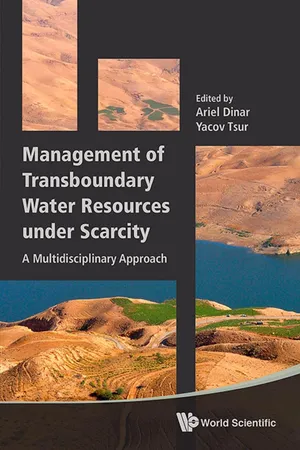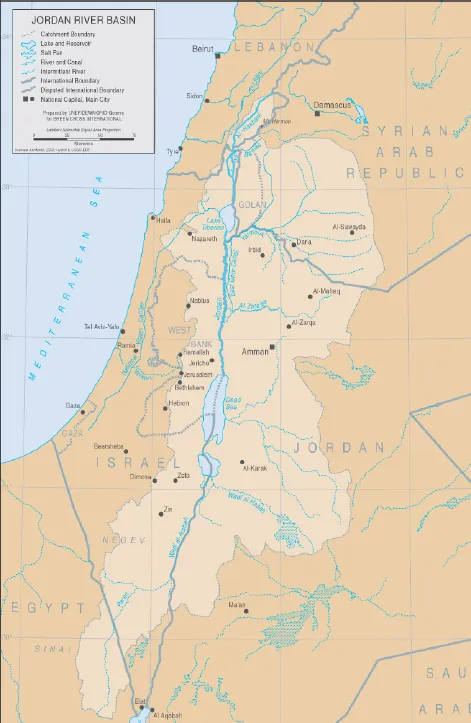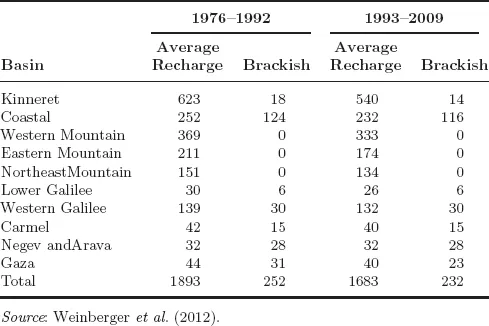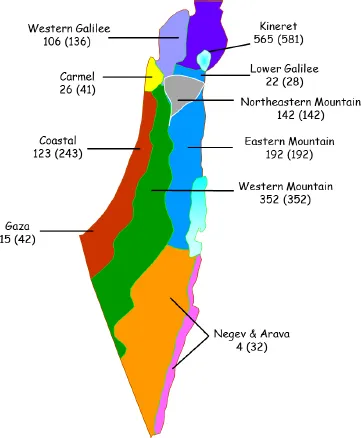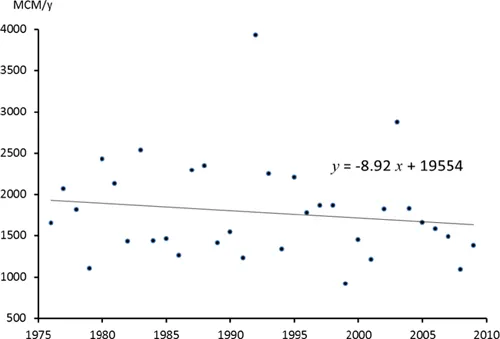![]()
Part I
ECONOMIC, INSTITUTIONAL, AND TECHNOLOGICAL ASPECTS IN MANAGEMENT OF TRANSBOUNDARY WATER UNDER SCARCITY
![]()
CHAPTER 1
CLOSING THE (WIDENING) GAP BETWEEN NATURAL WATER RESOURCES AND WATER NEEDS IN THE JORDAN RIVER BASIN: A LONG-TERM PERSPECTIVE
YACOV TSUR
Department of Environmental Economics and Management, The Hebrew University of Jerusalem, Rehovot, Israel
The supply of renewable natural water available in a sustainable fashion in the Jordan River Basin (JRB), comprising Israel, Jordan, and the Palestinian Authority (PA), will soon drop below 100 cubic meters (m3) per person per year. Drawing on recent technological progress and policy innovations, a comprehensive policy to address the region’s water problems in the long run is offered. The policy has a dual goal: to satisfy the needs of a growing population (domestic, irrigation, and industry) and to preserve important environmental amenities, including restoration of the lower Jordan River (LJR) and stabilization of the Dead Sea. The gap between natural water supplies and the basic needs of the growing population will be closed by conservation and desalination; at the same time, all domestic water will be recycled and will be available for reuse in irrigation and environmental restoration. Over time, the supply of recycled water that should be allocated for environmental restoration (accounting for the compensation of irrigators) will suffice to partially restore the LJR and contribute to the stabilization of the Dead Sea. The analysis is relevant in a wide range of real-world situations, where satisfying the basic needs of a growing population and preserving environmental amenities become critical.
Keywords: Dead Sea; Desalination; Environmental amenities; Lower Jordan River; Recycling; Water scarcity
1.1.Introduction
The average supply of natural water available in a sustainable fashion (without systematically drawing down water stocks) in the JRB, comprising Israel, Jordan, and the PA, will soon drop below 100 m3 per person per year. As a result, extensive diversions from natural sources have led to the deterioration, if not complete demolition, of natural stream flows and ecosystems. Two prominent environmental “victims,” shared by the three parties, are the LJR and the Dead Sea: the LJR’s flow has been reduced to a trickle of mostly brackish water and partially treated sewage and its historically rich ecosystem no longer exists (Gafny et al., 2010); the Dead Sea level has been declining at a rate exceeding 1 m per year with far reaching detrimental consequences to its surrounding environment (Becker and Katz, 2009; Tahal and Geological Survey of Israel, 2011; Rawashdeh et al., 2013). In this chapter, we propose a comprehensive policy to address the water problems of the JRB in the long run. The policy has a dual goal: first and foremost, to satisfy the essentials of the growing population in subsistence (drinking, hygiene) as well as agricultural (irrigation) and industrial production; and second, to maintain an acceptable level of environmental amenities, including partial restoration of the LJR and stabilization of the Dead Sea level. The proposed policy draws on recent technological progress and policy innovations. The analysis is relevant in a wide range of real-world situations, where the limited water resources make the dual goal of satisfying the needs of a growing population and preserving environmental amenities — a critical problem.
Water scarcity is a fuzzy and complex concept because of the “liquid” nature of the resource, which often exhibits large temporal and spatial variability, variation in quality, and dependence on idiosyncratic climate conditions (e.g., evapotranspiration). At the root level, water scarcity has to do with the availability of water needed to satisfy human livelihoods, including drinking, washing, and food production as well as environmental preservation. The ability to satisfy these needs depends both on the available quantity of renewable, natural water as well as on how this water is managed. A region can experience abundance of water some of the time (e.g., in the winter or monsoon periods) and a severe shortage in other times (e.g., in the summer or dry periods) and water shortage depends also on demand management and on the ability to transfer water across time and across space (from water-abundant periods/locations to water-scarce periods/locations), requiring, inter alia, storage and conveyance facilities. It is thus understandable that multiple indices of water scarcity exist with no consensus regarding which one to use in any given circumstance (discussions of the different water scarcity indicators can be found in Rijsberman [2006], Gleick [2002], and references they cite).
These qualifications notwithstanding, a rough and widely used index of water scarcity is the supply of renewable (i.e., available in a sustainable fashion) natural water suitable for human use, measured in units of cubic meters per person per year. Widely accepted measures of water scarcity defined by this index are due to Falkenmark et al. (1989). Based on estimates of water requirements for households, agricultural, industrial, and environmental needs, Falkenmark et al. (1989) proposed the following thresholds: regions whose renewable water supplies fall below 1700, 1000, or 500 m3 per person per year are said to experience water stress, water scarcity, or absolute scarcity, respectively. The threshold of 100 m3 per person per year is often mentioned as the water supply needed to satisfy basic human needs (Gleick, 1996) and we call this threshold subsistence scarcity. Water scarcity measures based on annual supplies of natural renewable water available per person are popular because their calculation requires data that are often available. Notice that these indices change over time due to population growth.
We begin in the next section with a description of the water scarcity situation in the JRB and its projected time evolution. We shall see that the region as a whole will soon suffer from subsistence scarcity, and parts of it have already entered this phase. In Section 1.3, we discuss recent technological progress in desalination and policy innovations that have been used to deal with water scarcity in Israel and show in Section 1.4 how these policies underline the basic principles of a comprehensive solution to the water shortage problem in the region. Section 1.5 discusses how the environmental goals of partially restoring the LJR (the stretch of the river between Lake Tiberias-Kinneret and the Dead Sea) and stabilizing the Dead Sea level can be incorporated within this comprehensive water policy. Section 1.6 concludes.
1.2.Water Scarcity in the JRB
We consider the part of the JRB that comprises Israel, Jordan, and the PA (see Fig. 1.1).1 The situation of the three parties is not symmetric: while Israel and Jordan are free to set their water policies, the PA is limited as it does not yet possess the same state status. While this political obstacle has consequences regarding feasible water policies in the short run, one hopes that it will be resolved and once this happens, these (short term) restrictions will no longer be effective. As this work takes a long-term perspective (as the title suggests), current political restrictions and mutual mistrusts among the parties are ignored and the emphasis is on what could be done under collaborative political conditions.
1.2.1.Water Resources
We discuss first the water resources of Israel and the PA jointly, followed by the water resources of Jordan.
1.2.1.1.Water resources in Israel and the PA
Table 1.1 presents average recharge into the main water sources west of the Jordan River for the periods 1976–1992 and 1993–2009. It also gives the quantities of brackish water recharge, where brackish water refers to water with chloride concentration above 400 mg/L. To obtain quantities of fresh water recharge (with chloride concentration below 400 mg/L) one needs to subtract the brackish from the average, for example, the total average recharge of fresh water during 1993–2009 was 1683 − 232 = 1451 million cubic meters per year (MCM/y).2 Figure 1.2 provides a map view of Table 1.1. These are the quantities of natural water available to Israel and the PA on a sustainable fashion. Brackish water is unsuitable for drinking and when used for irrigation often requires mixing with good quality water to reduce salinity.
Figure 1.1: The JRB. The upper Jordan River extends between its headwater (at the confluence of the Dan, Banias, and Hatzbani) and Lake Tiberias-Kinneret. The LJR is the southern stretch of the river between Lake Kinneret and the Dead Sea.
Source: United Nations Environment Programme (http://www.grid.unep.ch/products/4_Maps/jordanb.gif).
Table 1.1: Average annual recharge (MCM/y) of main water sources west of the Jordan River and the share of brackish water (with chloride concentration above 400 mg/L).
Figure 1.3 shows the actual realizations of natural recharge for the period 1976–2009. It illuminates two features of renewable water resources in the JRB: high (temporal) fluctuations and a declining trend. Part of the declining trend (of 8.92 MCM/y) could be the result of climate change processes.
Figure 1.2: Average renewable (natural) supplies (with chloride concentration <400 mg/L), based on the 1993–2009 data of Table 1.1 (numbers in parenthesis give brackish water — with chloride concentration >400 mg/L).
Source: Weinberger et al. (2012).
1.2.1.2.Water resources in Jordan
Table 1.2 presents Jordan’s renewable water resources. The total average supply of renewable natural water in Jordan is 745 MCM/y on average.3
Figure 1.3: Actual observations of total natural water recharge of all major water sources (including brackis...
